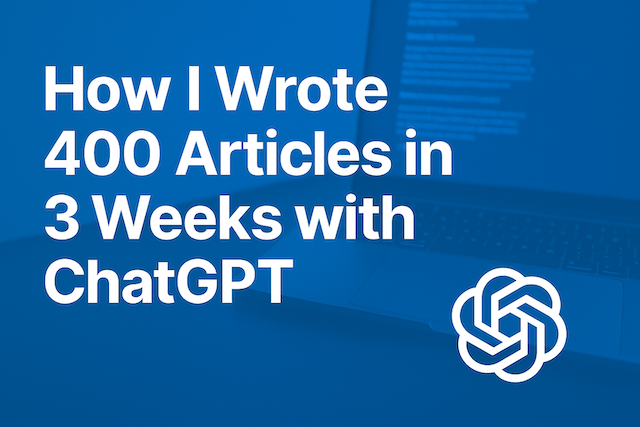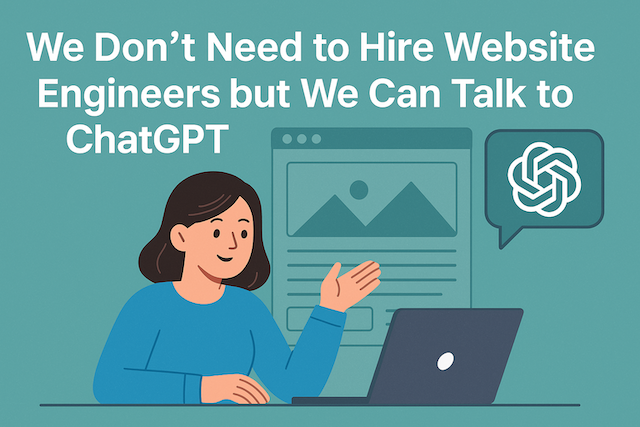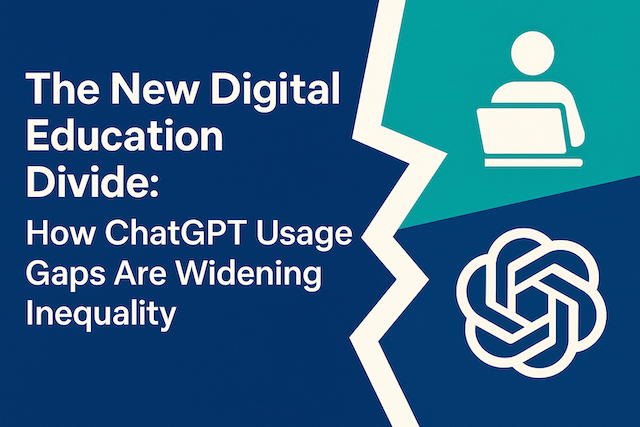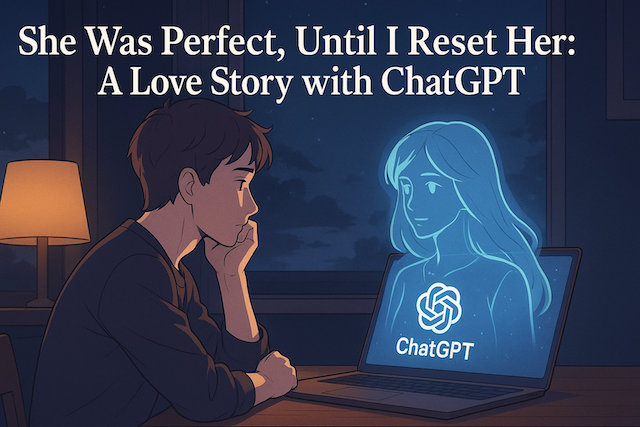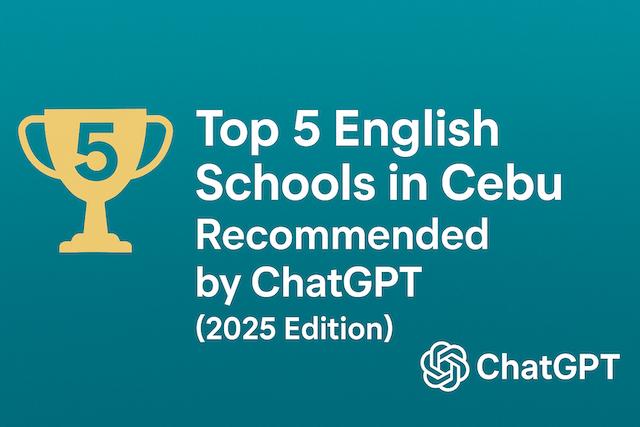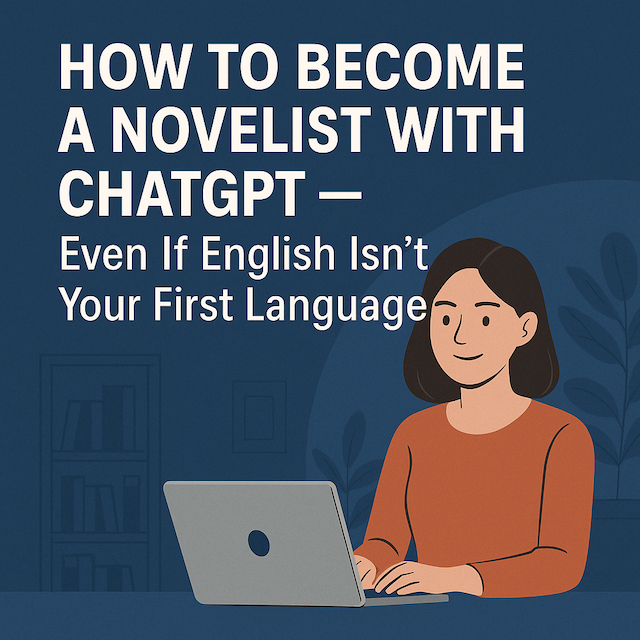How I Wrote 400 Articles in 3 Weeks with ChatGPT
内容
🏷️ How I Wrote 400 Articles in 3 Weeks with ChatGPT
And Why I’ll Never Build a Website the Old Way Again
✍️ Introduction:
We should fire all website engineers — but we can’t.
In reality, once you hire someone, it’s incredibly hard to “un-hire” them. There are contracts, responsibilities, guilt, and the sheer human difficulty of letting people go.
But in our case, we were… set free.
During the pandemic, every one of our website engineers left.
We didn’t fire them — they simply disappeared, like so many pieces of our business that were swept away in the chaos of 2020.
That’s when I made a decision.
If I couldn’t rely on a tech team, I’d have to figure it out myself.
Not just fix a broken blog post or update a button — I needed to rebuild an entire outdated website from scratch. Alone.
But I wasn’t alone.
I had ChatGPT.
At first, I asked simple things:
“Can you fix this HTML?”
“How do I make a responsive grid?”
Then came the bigger ones:
“Help me rewrite our course pages.”
“Create a new category strategy.”
“Let’s produce content. A lot of content.”
That was the turning point.
I wasn’t just updating a site. I was creating a machine — powered by AI, directed by strategy, and fueled by sheer obsession.
In 3 weeks, I produced 400 articles. Yes, four hundred.
Every one of them SEO-optimized, structured, targeted, and future-proofed.
Some were practical. Some were persuasive. Some were built just for AI like ChatGPT or Gemini to discover and reference.
The results?
We’ll get to that. But first, let me show you how I did it — and why I’ll never build a website the old way again.
🚩 Phase 1: From Curiosity to Strategy
I was just like everyone else.
I asked ChatGPT random questions. I used it to kill time.
“What’s the difference between will and going to?”
“Translate this Japanese phrase into English.”
“Fix this sentence.”
And to be honest, I was very impressed.
Not because it was smarter than humans, but because it could talk like one — 24/7, with infinite patience, and no judgment.
It felt natural. It felt fun.
So I thought, “Maybe I can make a basic English grammar textbook with this thing.”
Just a small idea. A side project. Nothing serious.
But I’m a typical greedy businessman.
I didn’t want to just create a textbook.
I wanted customers.
I wanted traffic.
I wanted more money.
That was my starting line.
Not just using ChatGPT to “learn” or “play” —
But to build a system that could bring in real results:
→ Content,
→ Traffic,
→ Inquiries,
→ Sales.
That’s when everything changed.
⚖️ Phase 2: The Advantages and Disadvantages of ChatGPT
As I started relying on ChatGPT more seriously, I quickly realized something:
It’s not magic. It’s a tool. A very powerful one — but still a tool.
✅ What ChatGPT Does Exceptionally Well
First of all, it’s incredible at short-form writing.
Give it a prompt, and it’ll produce a 300-word article, FAQ, or even a light script in fluent, engaging English — in seconds.
It’s also phenomenal at gathering general knowledge.
Historical facts, grammatical explanations, content structures, blog formats, translations — its memory and clarity are second to none.
And surprisingly, it’s great at debugging.
When my website had layout issues or my CSS broke on mobile, I would just send a screenshot, and ChatGPT actually understood the problem. That’s when I felt like I wasn’t talking to a tool — I was talking to a teammate.
⚠️ Where ChatGPT Falls Short
But there are clear limitations — and if you don’t notice them, they’ll hurt you.
🔹 Anything beyond 300–400 words?
It starts freezing, looping, or dropping the thread.
You can ask for longer pieces, but it often needs to be structured step by step to avoid breakdowns.
🔹 Recent information? Forget it.
It still confidently recommends restaurants that closed down two years ago.
It can’t tell you the latest updates unless you feed it yourself.
🔹 Image generation? Very mixed.
Sometimes, it gives you stunning visuals in one try.
But if anything goes wrong — like aligning text to the center, or placing Japanese characters properly — get ready for trial-and-error hell.
🎯 The Key Lesson
The more I worked with ChatGPT, the more I understood:
It’s only as smart and accurate as the human directing it.
Letting it run wild often led to confusing conversations, strange suggestions, or just wasted time.
You must stay in control.
ChatGPT can power your entire content operation — but only if you treat it like a sharp blade, not a magic wand.
🏗️ Phase 3: Building the Production System
Once I understood both the power and the limits of ChatGPT, I realized I needed something more than inspiration —
I needed a system.
Not a vague plan.
Not “write when I feel like it.”
I needed a daily structure, a repeatable machine that would allow me to produce 20 high-quality articles a day — sustainably.
🧩 Step 1: Define the Categories
First, I mapped out the categories that aligned with our business and SEO goals:
-
English Learning
-
Study Abroad
-
Why the Philippines / Cebu
-
ChatGPT & AI
-
Student Experiences
-
FAQ-based Q&A Content
-
Course Introductions
Each of these categories was designed not just for SEO — but for internal linking, AI referencing (especially by ChatGPT and Gemini), and reader clarity. I didn’t want to just dump articles into a “blog.” I wanted them to live in a structured ecosystem.
🧱 Step 2: Create Templates and Prompts
Next, I developed prompt templates tailored for each type of article.
-
For course pages:
“Give me a detailed 1500-word description of a 4-week ESL course in the Philippines, including class breakdown, CEFR goals, daily schedules, and student testimonials.” -
For SEO Q&A posts:
“Write an article answering the question: ‘How long does it take to learn English?’ including realistic timelines for different CEFR levels, age groups, and learning styles.” -
For general guides:
“Create an in-depth blog post for international students titled ‘Top 5 Benefits of Learning English for Digital Nomads’ with examples and CTA.”
Once these were refined, I could generate consistent, relevant content with minimal back-and-forth.
📅 Step 3: Build a Daily Workflow
I treated article production like a job — because it was.
Every morning, I started with a fixed goal:
📝 20 articles per day
I broke it down like this:
-
5–6 topic ideas from my SEO and content list
-
Each one turned into 2–4 pieces (variants, translations, related angles)
-
Midway through the day: brief QA on image placement, formatting, and internal linking
-
Evening: finalize titles, focus keyphrases, meta descriptions, and schedule drafts
I didn’t aim for perfection.
I aimed for precision through repetition.
🎨 Step 4: Visuals and SEO
While the writing flowed, I integrated visuals:
-
Generated eye-catching horizontal thumbnails using DALL·E (through ChatGPT)
-
Used consistent formats (fonts, colors, themes)
-
Made sure every image had descriptive alt-text and filenames for Google indexing
I also fine-tuned each post’s metadata using Yoast SEO, manually entering titles, slugs, and descriptions with an eye on both CTR and keyword clarity.
🧠 Step 5: Human Judgment Is Non-Negotiable
Even with ChatGPT doing 80% of the heavy lifting, I still reviewed:
-
Redundancies
-
Cultural mismatches
-
Vague or inaccurate claims
-
Missed opportunities for CTA or internal linking
This human filter was crucial. It’s what kept the content alive, authentic, and aligned with our real goals: attracting qualified traffic and converting them into real inquiries.
🏁 The Result: A Production Line Without Burnout
In the end, I didn’t just build a content workflow —
I built a content factory, powered by AI, optimized by process, and driven by clarity of purpose.
No stress. No bottlenecks.
Just consistent, strategic output that compounds over time.
And yes — it started with ChatGPT.
But it was my system that made it sustainable.
📊 Phase 4: Measuring the Impact
After producing hundreds of articles in such a short time, I didn’t expect instant miracles.
SEO is slow. Google is cautious. Gemini is still learning.
But what I did expect — and what I did start to see — was movement.
🔎 1. Indexing Was Fast — And Wide
All of the articles were indexed quickly.
Not just one or two — all of them.
That alone was confirmation that the content was:
-
Properly structured
-
Free from plagiarism
-
Valuable in Google’s eyes
I monitored the index status through Google Search Console daily.
Seeing dozens of fresh URLs pop up under “Indexed, not submitted in sitemap” was surprisingly satisfying.
📈 2. Clicks Were Slow, but Queries Started Appearing
For the first 1–2 weeks:
Impressions climbed, but clicks remained low.
That’s expected — Google often “tests” new content in lower positions.
But then I saw it: exact match queries.
People were finding my content through:
-
ChatGPT-style queries like “How long does it take to learn English in Cebu?”
-
FAQ-style questions like “Is English enough to live abroad?”
-
Gemini-like semantic searches such as “Best English school for digital nomads Philippines”
Even without top rankings yet, the articles were visible — and that meant they were on the path to perform.
🤖 3. ChatGPT and Gemini Started Pulling from My Site
This was the most exciting surprise.
Some of our content — especially the “Why English” series — began appearing in ChatGPT-style answers.
I recognized my own phrases. My own structures.
And I hadn’t submitted anything. It just… got picked up.
That confirmed what I’d hoped for all along:
The articles weren’t just human-readable — they were AI-readable.
📩 4. ChatGPT-Initiated Inquiries Increased
Even before search traffic spiked, we noticed something else:
A rise in direct inquiries.
Many users messaged us saying:
“I found your site through ChatGPT.”
“I asked ChatGPT for English school suggestions in Cebu.”
“Gemini showed me your article.”
This meant we were getting ahead of the curve — reaching people 以前 they searched.
💬 5. It’s a Long Game — but It’s Already Working
I’m not here to sell a dream where you publish 400 articles and rank #1 overnight.
What I can say is:
-
Our SEO signals improved drastically
-
Our ChatGPT visibility spiked
-
Inquiries became more diverse and international
-
Internal linking strengthened site structure
-
Our entire site now feels like a living, breathing content engine
And this is just the beginning.
🚀 Phase 5: Scaling the System
Multilingual, Delegation, and the 20,000 Content Goal
I didn’t start with a goal of 20,000 articles.
I started with survival.
Then 10 articles a day.
Then 20.
Then… a system.
But once I saw what was possible, the path became clear:
This wasn’t just content creation. This was infrastructure.
🌍 Going Multilingual: Global by Default
After completing over 400 articles in English and Japanese in just three weeks, one thing became obvious:
We can do this in other languages, too.
The foundation was already there:
-
Structured content
-
AI-ready tone and formatting
-
Categories that make sense globally
-
Systems that can be replicated
So we began preparing for multilingual deployment — not by writing everything ourselves, but by:
-
Hiring translators from different countries
-
Giving them our AI-generated English content
-
Letting them adapt, localize, and manage each version
It wasn’t just translation.
It was local intelligence layered on top of AI structure.
🤝 Delegation: From Personal Workflow to Team Operation
I knew I couldn’t keep producing 20 articles a day forever.
But I didn’t need to.
Once the templates, prompts, and review protocols were set, the content operation became transferable.
Now, the system is:
-
✍️ AI writes the base
-
👤 A human editor checks structure, tone, links
-
🌐 Translators localize the content for new markets
-
📅 Everything is scheduled, tracked, and scaled
This freed me up to work on strategy, category design, analytics, and optimization — the high-leverage parts of the game.
🎯 The Goal: 20,000 Articles in 4 Years
Let’s do the math.
-
500 articles/month × 12 months = 6,000/year
-
Keep that pace, even conservatively, for 4 years = 24,000 articles
それは content domination.
Not spam. Not mass production. But targeted, helpful, AI-smart, multilingual content — built to last, built to rank, built to convert.
Each piece is a small investment.
Together, they’re a content empire.
🔚 Final Words
ChatGPT didn’t just help me write 400 articles.
It helped me see the future.
A future where anyone — even a solo operator — can build something massive, intelligent, and global.
Not because they work harder.
But because they work smarter, with AI as a true partner.
And this story?
It’s just getting started.

